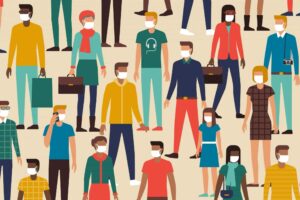
Study Overview:
In mid-March 2020, the coronavirus disease 2019 (COVID-19) pandemic transformed most aspects of American life. Confronted by inadequate testing capacity, unprecedented surges in demand for medical care and rapidly escalating death rates, public leaders asked people to stay at home to protect themselves and their communities. Yet, uncertainty about basic aspects of the virus (e.g., asymptomatic rate), the slow roll-out of diagnostic testing, the uneven pace of disease spread in communities across the U.S., and rapidly escalating economic distress have contributed to challenges in providing consistent, coherent information to the public. Much remains unknown about how the American public has responded to the COVID-19 pandemic, including perceptions about the importance of social distancing and the sources of information the public is relying on to understand how to act to slow disease transmission.
To begin answering these questions, we fielded the Johns Hopkins COVID-19 Civic Life and Public Health Survey Wave 1 between April 7 and April 13, 2020. This national public opinion study, a partnership of the Bloomberg School of Public Health and the SNF Agora Institute of Johns Hopkins University, was administered using NORC’s probability-based AmeriSpeak® Panel, which is designed to be representative of the U.S. adult population.
The goal of the survey is to understand how civic and political institutions like the news media and community-based organizations are shaping public views and behaviors regarding the pandemic. We hope this data will be used to make recommendations to policymakers and other decision-makers on how civic and political organizations might respond to the pandemic. It will also help them better understand public support for policies aimed at lessening the pandemic’s effects on people’s lives.
Read More:
- “Public Support for Social Safety-Net Policies for COVID-19 in the United States,” April 2020,” article published in the American Journal of Public Health, October 15, 2020
- “The Pandemic’s Mental Toll: More Ripple Than Tsunami,” article published in The New York Times, June 21, 2020
- “Trust in Science and COVID-19,” essay published on COVID-19: School of Public Health Expert Insights website, June 17, 2020
- “Psychological Distress and Loneliness Reported by US Adults in 2018 and April 2020,” research letter published on JAMA Network, June 3, 2020
- “Survey Finds Increase in Psychological Distress Reported among U.S. Adults During the COVID-19 Pandemic,” news article published on Johns Hopkins’ Hub, June 3, 2020
Research Team:
- Kelly Anderson, Johns Hopkins Bloomberg School of Public Health
- Colleen L. Barry, PhD, MPP, Johns Hopkins Bloomberg School of Public Health
- Hahrie Han, PhD, SNF Agora Institute at Johns Hopkins University
- Beth McGinty, PhD, MS, Johns Hopkins Bloomberg School of Public Health
- Rachel PressKreischer, Johns Hopkins Bloomberg School of Public Health
Primary Questions:
- How do connections with intermediary civic and political institutions affect public attitudes and behaviors toward the COVID-19 pandemic overall and particularly within vulnerable subgroups, including low-income and racial minority groups, and those most prone to mental health and substance use challenges and socially isolated?
- What are the levels of support for social policies during COVID-19, including universal health insurance, paid sick leave benefits, unemployment benefits, minimum wage, family medical leave, universal basic income, job displacement support, and others?
- How has COVID-19 influenced psychological distress and loneliness among US adults?
- Do respondents’ answers to questions 1-3 differ in the early versus later stages of the pandemic?
